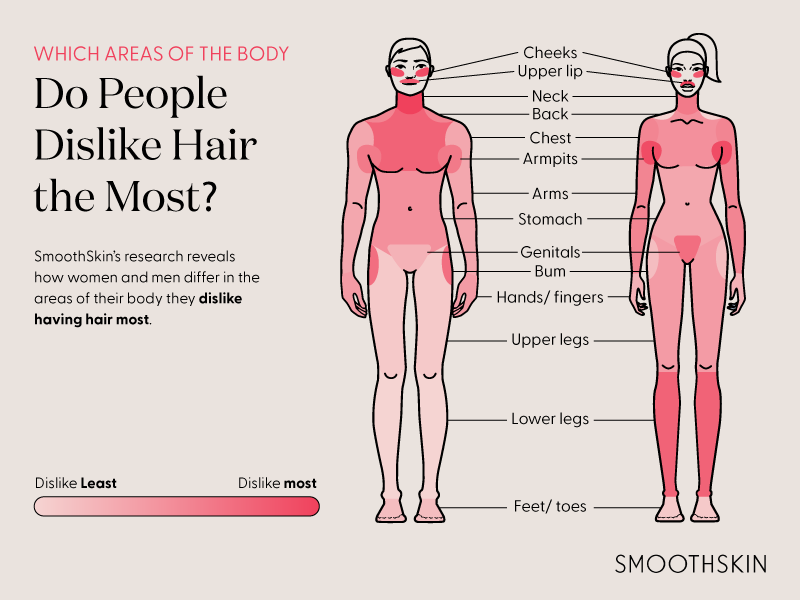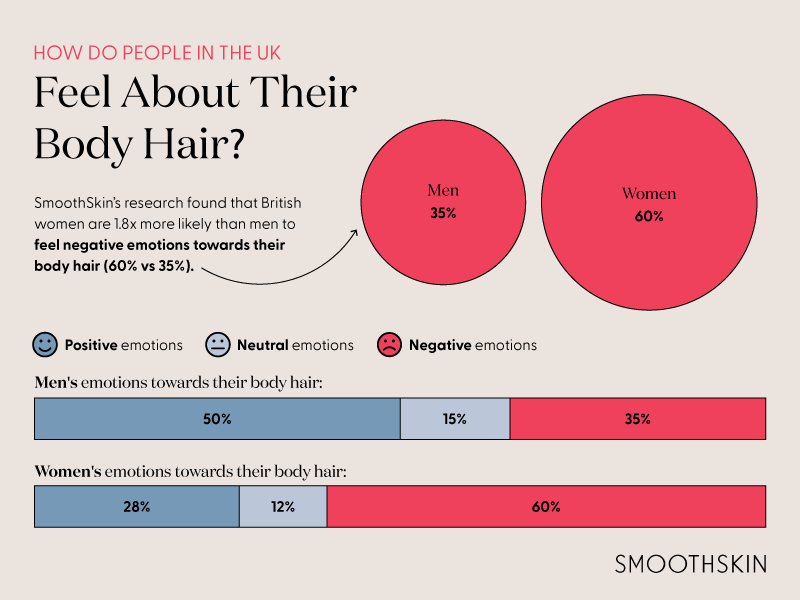Hairy & Happy? How the nation feels about body hair…
There’s a whole lot tangled up in how we feel about our body hair. And why wouldn’t there be? Whether you have a lot, a little, or none at all – it’s one of our most prominent features.
Not only is our hair one of our most distinguished features, but it also plays a huge part in how we shape our appearances and our identities. For some, their body hair is a source of pride and power. Whereas for others, the relationship they have with their body hair can be somewhat complicated.
Society shapes us to have certain expectations of where it’s acceptable to have body hair. The Western world’s long-shaped gender dynamics tell men their body hair is the ultimate sign of masculinity. Whereas, for women, there can be a certain stigma around having body hair – particularly in those areas where men are told to embrace it.
However, the rise of the hair positivity movement of recent years means more and more of us are embracing our body hair where we perhaps didn’t before.
Here at SmoothSkin, we believe the power of body hair lies within the power of choice.
That’s why we’ve surveyed 1,000 people* from across the UK to uncover the trends in the modern world of hair removal, looking at things like the age body hair removal begins, the emotions people feel towards their body hair, which parts of their body people dislike having hair most and many more. Keep reading to find out what they said.
Jump to:
Which areas of the body do people dislike having hair the most?
Many people will remember the iconic (or depending on your own personal opinion “scandalous”) picture of Julia Roberts in 1999 when she wore a dress that exposed her unshaven armpits at the Notting Hill premiere.
While the public perception of unshaven female body hair has somewhat changed since then, our research found that there are still key differences between men’s and women’s preferences of where they have body hair:
Female facial hair removal is an increasingly popular option as our research found that the average woman in the UK dislikes the hair on their upper lip most.
Following the upper lip, the armpits take the second-most disliked spot for body hair. Comparatively, for men, the armpits are placed 5 points lower as the sixth-most disliked area of body hair.
The rest of the top 5 most-disliked places to have body hair for British women are the cheeks, lower legs, and bikini line / genitals.
Interestingly, our research found that women are 2.5 times more likely than men to feel societal pressure to remove their body hair (10% vs 4%). They’re also 1.5 times more likely to feel like society has different expectations for body hair for women than it does for men (26% vs 15%).
Men’s most disliked places to have body hair are mostly made up by the facial area (where men more traditionally remove hair). For the average man in the UK, the most disliked place to have body hair is the neck. Following the neck were the cheeks, upper lip, chest, and bum.
Although there may be areas where we’d rather be smooth than hairy, body hair actually has important functions for both men and women. Our body hair helps protect our skin, regulates our temperatures and, in certain areas, protects us from dirt and friction. So, remember that your hair has lots of evolutionary benefits, if you’re ever feeling negatively about it.

Female facial hair removal is an increasingly popular option as our research found that the average woman in the UK dislikes the hair on their upper lip most.
Following the upper lip, the armpits take the second-most disliked spot for body hair. Comparatively, for men, the armpits are placed 5 points lower as the sixth-most disliked area of body hair.
The rest of the top 5 most-disliked places to have body hair for British women are the cheeks, lower legs, and bikini line / genitals.
Interestingly, our research found that women are 2.5 times more likely than men to feel societal pressure to remove their body hair (10% vs 4%). They’re also 1.5 times more likely to feel like society has different expectations for body hair for women than it does for men (26% vs 15%).
Men’s most disliked places to have body hair are mostly made up by the facial area (where men more traditionally remove hair). For the average man in the UK, the most disliked place to have body hair is the neck. Following the neck were the cheeks, upper lip, chest, and bum.
Although there may be areas where we’d rather be smooth than hairy, body hair actually has important functions for both men and women. Our body hair helps protect our skin, regulates our temperatures and, in certain areas, protects us from dirt and friction. So, remember that your hair has lots of evolutionary benefits, if you’re ever feeling negatively about it.
How do people feel about their body hair?
While humans have been removing body hair for thousands of years (around 3000 BC, to be exact), it was only in 2018 that the very first television advert for female razors showed female body hair. At SmoothSkin, we’ll always show real user results with real body hair.
However, hairlessness wasn’t always a societal mandate for women. It’s believed that the expectation for women to have hairless bodies didn’t become popular until the early 20th century when, in 1915, Harper’s Bazaar ran a campaign for the “necessary” removal of body hair.
And this campaign clearly had a real societal impact on our body hair expectations, but how have these standards impacted the emotions we have about body hair today, over 100 years later?
Our research found that not only are there key differences in the preferences men and women have for body hair but also in the emotions they feel towards it.

We found that women in the UK are nearly 2 times more likely than men to have negative emotions towards their body hair (60% vs 35%). Coincidingly, men were found to be nearly 2x as likely as women to have positive emotions towards their body hair (50% vs 28%).
For men, the majority (50%) feel positive emotions towards their body hair, with some of the top emotions felt including “acceptance” (29%), “happiness” (10%), and “confidence” (8%).
On the contrary, the majority of women (60%) hold negative emotions with their body hair. For women, the top emotion felt is “annoyance” (26%), followed by “uncomfortable” (12%), and “embarrassment” (10%).
In spite of a more positive move towards body hair, with the subject becoming less taboo in the media, only 1% of women feel empowered by their body hair, compared to 3% of men.
How often do people in the UK remove their body hair? And how long do they spend doing it?

When it comes to the specific body parts people remove hair from most often, our research found that for women, the facial area (including cheeks, upper lip, neck, and jawline) and the armpits are the body parts they most often remove hair from. Our study found that women get rid of facial hair and armpit hair every 5 days on average.
For men, the facial area was the place they most often remove body hair, averaging every 2 days.
Looking at how long people spend removing body hair, our research found that men in the UK spend an average of 17 minutes and 52 seconds each week, whereas women spend around 15 minutes and 44 seconds.
Over a year, that’s around 15 hours, 29 minutes, and 14 seconds for men. And 13 hours, 37 minutes, and 58 seconds for women.
But at exactly what age do people begin removing body hair?
People generally start growing ‘adult’ body hair when they reach puberty. In the UK, the average age for girls to start puberty is 11, while for boys, the average age is 12.
While body hair usually starts growing once people hit puberty, it doesn’t necessarily come all at once. And, our research found quite a significant disparity in the ages that men and women begin removing their body hair.
Our study found that female hair removal in the UK begins at an average age of 15 years and 7 months old, whereas the average male body hair removal begins at 17 years and 10 months old. That’s a full two years and 3 months younger for women.
Our research also found that by the age of just 13, nearly 3 times the number of women had begun removing body hair (30%) as men (9%).
By the age of 16, the majority (56%) of British women had begun removing their body hair, whereas just under a third (32%) of men had.
What are the most common hair removal methods?

There’s no denying that hair removal methods can be a contentious issue. With what seems like endless options on the market, it can be tricky to figure out which hair removal method is best for you.
For many people who remove body hair, finding a hair removal method that works best for them can be a trying journey. Our research found that around 1 in 3 (34%) people feel itchy after shaving, and the same amount of people find hair removal time-consuming. Another 1 in 5 (20%) describe hair removal as “inconvenient”.
But once you do find your perfect hair removal solution, it’s a blissful feeling.
Our research found that traditional shaving is still the most tried hair removal method for Brits, with 9 in 10 (89%) of the hair-removing population having used this method before. Following shaving, the second-most tried method of hair removal for Brits is waxing, with over a third (35%) trying this.
Beyond the two most commonly tried methods of hair removal, we found that women in the UK are around 3 times more likely than men to try alternative hair removal or disguising methods:
- Women are 4.8x more likely to have tried epilation (19% vs 4%).
- Women are 3.4x more likely to have used hair removal creams (47% vs 14%).
- Women are 3x more likely to have tried threading (18% vs 6%).
- Women are 2.6x more likely to have tried tweezing (44% vs 17%).
- Women are 2.5x more likely to have tried bleaching (5% vs 2%).
- Women are 2x more likely to have tried sugaring (4% vs 2%)
- Women are 1.5x more likely to have tried laser hair removal (9% vs 4%).
But what about IPL hair removal? Currently, only around 4% of people who remove hair in the UK say they’ve tried IPL technology despite it saving you time, and reducing common problems that traditional hair removal methods cause, such as itching or painful ingrown hairs.
The beauty of IPL technology also means that it’s suitable for use in all the areas our research shows people most-commonly remove body hair from, meaning there’s no need to switch up hair removal methods for different areas.
What’s next for hair removal?
Whether you choose to remove your body hair or you choose to wear some or all of it proudly, here at SmoothSkin, we believe no one should ever have to apologise for their choice.
In recent years, it’s clear that the taboos towards some areas of body hair have been lifted little by little, and a large part of the identification we hold in body hair comes from the choice of how you want to wear it. Choosing only what feels good for you, not for anyone else.
When you want to achieve smooth skin, it shouldn’t be complicated. That’s why we’re here.
*Consumer research survey of 1,000 UK adults who remove body hair conducted via 3Gem between 20th-26th November 2024.
